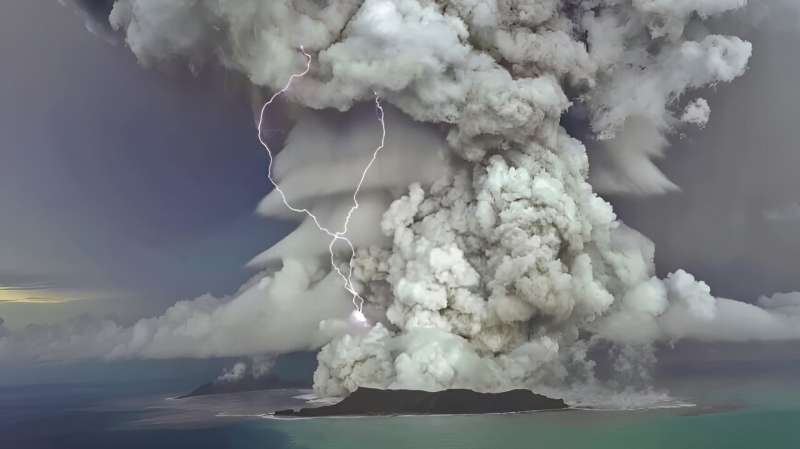This article has been reviewed according to Science X's editorial process and policies. Editors have highlighted the following attributes while ensuring the content's credibility:
fact-checked
peer-reviewed publication
trusted source
proofread
Study examines how massive 2022 eruption changed stratosphere chemistry and dynamics

When the Hunga Tonga-Hunga Ha'apai volcano erupted on January 15, 2022 in the South Pacific, it produced a shock wave felt around the world and triggered tsunamis in Tonga, Fiji, New Zealand, Japan, Chile, Peru and the United States.
It also changed the chemistry and dynamics of the stratosphere in the year following the eruption, leading to unprecedented losses in the ozone layer of up to 7% over large areas of the Southern Hemisphere, according to a recent study published in the Proceedings of the National Academy of Sciences from the Harvard John A. Paulson School of Engineering and Applied Sciences (SEAS) and the University of Maryland.
Driving those atmospheric changes, according to the research, was the sheer amount of water vapor injected into the stratosphere by the undersea volcano. The location of the stratosphere is approximately 8–30 miles above Earth's surface and is where the protective ozone layer resides.
"The Hunga Tonga-Hunga Ha'apai eruption was truly extraordinary in that it injected about 300 billion pounds of water into the normally dry stratosphere, which is just an absolutely incredible amount of water from a single event," said David Wilmouth, a project scientist at SEAS and first author of the paper.
"This eruption put us in uncharted territory," said Ross Salawitch, professor at the University of Maryland's Earth System Science Interdisciplinary Center and co-author of the study. "We've never seen, in the history of satellite records, this much water vapor injected into the atmosphere and our paper is the first that looks at the downstream consequences over broad regions of both hemispheres in the months following the eruption using satellite data and a global model."
The Hunga Tonga-Hunga Ha'apai eruption was the largest explosion ever recorded in the atmosphere. The eruption hurled aerosols and gases deep into the stratosphere. Some material reached the lower mesosphere, more than 30 miles above the Earth's surface, altitudes never recorded from a volcanic eruption. Previous studies found that the eruption increased water vapor in the stratosphere by 10% worldwide, with even higher concentrations in some areas of the Southern Hemisphere.
Wilmouth, Salawitch and the rest of the research team used data from the Microwave Limb Sounder (MLS) aboard the NASA Aura satellite, to track not only how that water vapor moved across the globe but also monitor temperature and levels of chlorine monoxide (ClO), ozone (O3), nitric acid (HNO3), and hydrogen chloride (HCl) in the stratosphere for the year following the eruption. They then compared those measurements to data collected by MLS from 2005 to 2021 prior to the eruption.
The team found that the injection of water vapor and sulfur dioxide (SO2) changed both the chemistry and the dynamics of the stratosphere. In terms of chemistry, the SO2 led to an increase in sulfate aerosols, which provided new surfaces for chemical reactions to occur.
"Certain reactions that might not happen at all or only happen slowly can happen faster if there are aerosols available on which those reactions can take place," said Wilmouth. "The injection of SO2 from the volcano allowed sulfate aerosols to form and the presence of water vapor led to the additional production of sulfate aerosols."
The increased sulfate aerosols and water vapor kicked off a chain of events in the complex atmospheric chemistry that led to widespread changes in the concentrations of a number of compounds, including ozone.
The extra water vapor also had a cooling effect in the stratosphere, leading to a change in circulation, which drove decreases in ozone in the southern hemisphere and an increase of ozone over the tropics.
The researchers found that the peak decrease in ozone occurred in October, nine months after the eruption.
"We had this enormous increase in water vapor in the stratosphere with modest increases in sulfate that set off a series of events that led to significant changes in temperature and circulation, ClO, HNO3, HCl, O3, and other gases," Wilmouth said.
Next, the researchers hope to continue the study by following the impact of the volcano into 2023 and beyond as the water vapor moves from the tropics and midlatitudes to the Southern Hemisphere pole, where it has the potential to amplify ozone losses in the Antarctic. The water vapor is expected to stay elevated in the stratosphere for a period of several years.
The research was co-authored by James Anderson, the Philip S. Weld Professor of Atmospheric Chemistry at SEAS; Freja Østerstrøm and Jessica Smith.
More information: David M. Wilmouth et al, Impact of the Hunga Tonga volcanic eruption on stratospheric composition, Proceedings of the National Academy of Sciences (2023). DOI: 10.1073/pnas.2301994120
Journal information: Proceedings of the National Academy of Sciences




















